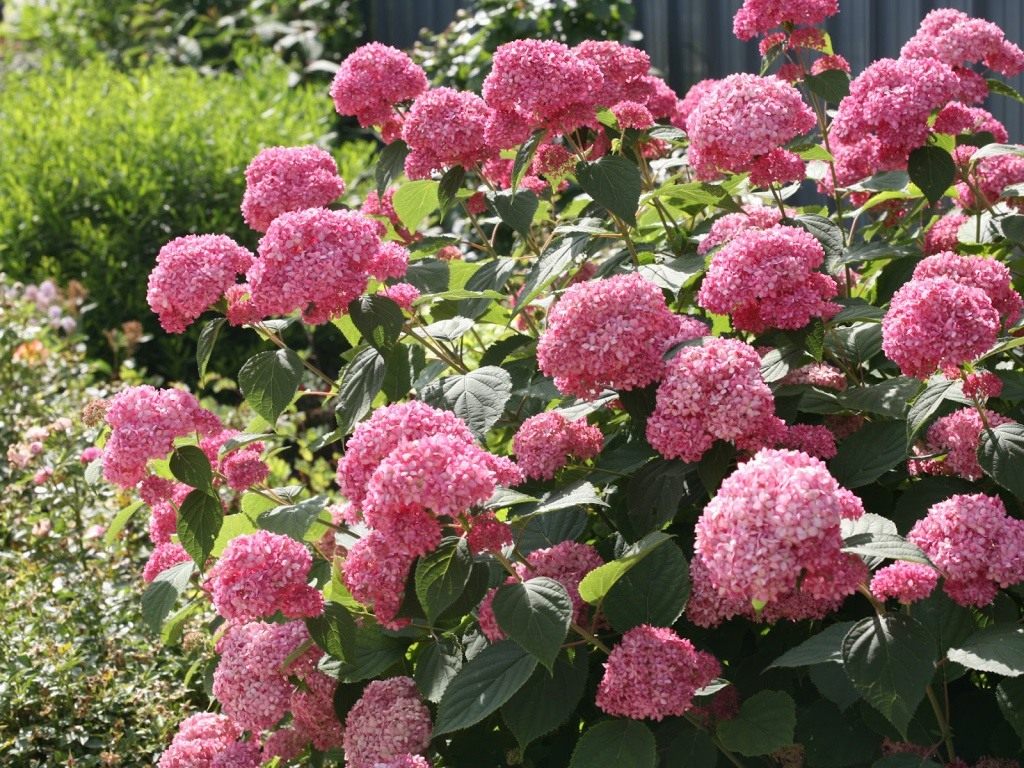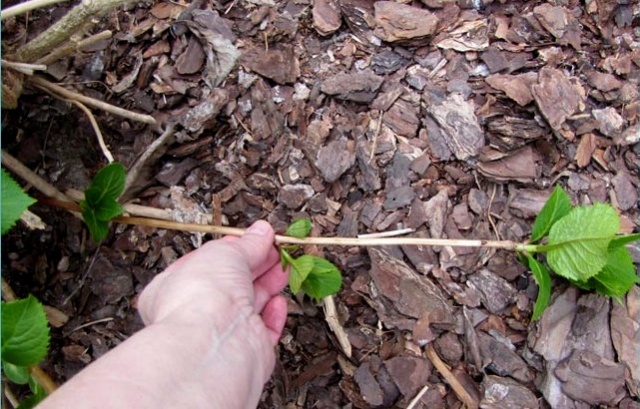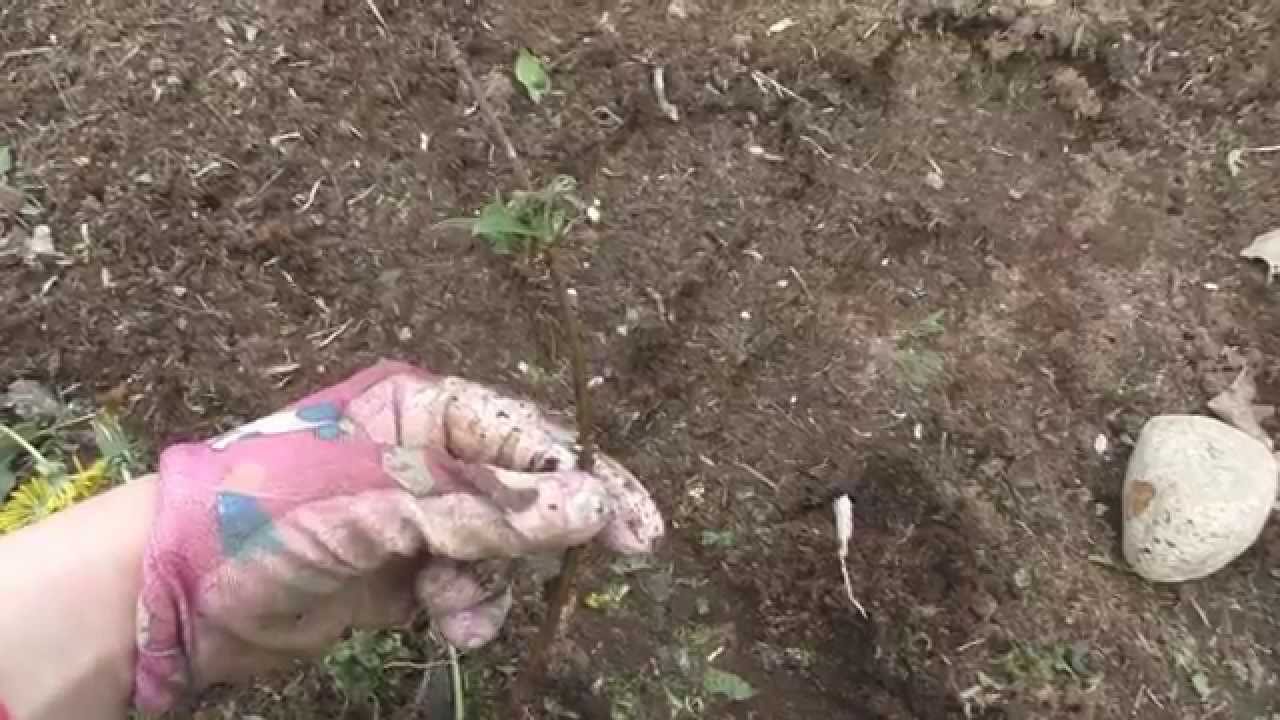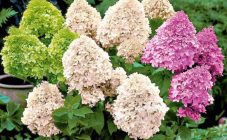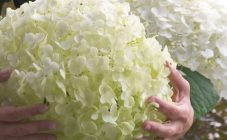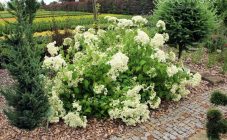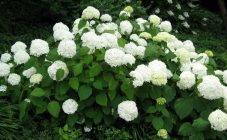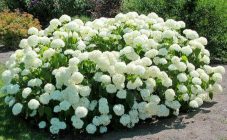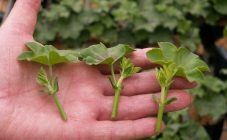Content:
Treelike hydrangea is a spectacular flowering plant, quite winter-hardy, successfully spreading in Russian gardens. The easiest way to propagate this hydrangea species is by cuttings. Almost all cuttings take root, especially if they have been properly treated with root stimulants.
Description of the hydrangea tree variety
This is a large-flowered, picturesque shrub with a shoot height of 1-2 m and a superficial root system. Treelike hydrangea is best planted in semi-shady places. The trunks are lignified after a year. The bark is flaky. Young shoots are slightly fluffy, green. The plant has large, delicate, bright green leaves up to 18-20 cm long, 10-12 cm wide. They retain their shade in autumn, only in some varieties they turn slightly red.
Shield-shaped inflorescences up to 15 cm in diameter are composed of white-cream or slightly greenish flowers with a diameter of 2 cm. There are pink-reddish tree-like varieties. Hydrangeas bloom from July to late September. The inflorescences contain flowers from which seeds develop. They are in the center. Sterile, large flowers, bordered.
Treelike hydrangea tolerates frosts up to 30 ° C. Even if the shoots freeze, the bush is restored from the root. The plant is moisture-loving, in sunny areas it requires regular watering with the obligatory mulching of the trunk circle. Prefers soils with a pH of 5, but it is this species that tolerates alkaline substrates more easily than other hydrangeas. Hydrangea in the spring can reproduce without hassle by dividing the roots and layering. Recognized crop cultivation by cuttings.
Breeders brought outand different decorative varieties based on a natural species that grows in the east of North America:
- snow-white Annabelle;
- greenish cream Grandiflora;
- pink Invincibelle (Pink Annabelle);
- white, with strong stems Incredibol (Strong Annabel).
How to propagate hydrangea by cuttings
Cuttings are easy to select when thinning the bush. This is a convenient option in response to the worries of summer residents, how to propagate a tree hydrangea to decorate the site. It is better to take pieces from the lower side stems that grew on last year's shoots. If the hydrangea on the side where the branch is taken for reproduction is well lit, the buds are large, developed.
How to choose and prepare a cutting
For cuttings, you need a shoot with a top, a green stem. The lignified stem does not take root well, it may not give root processes. Cutting requirements:
- choose the fragment of the green stem where there are 2-3 nodes from which the opposite leaves grow;
- handle length - 13-18 cm;
- cuts are made 5 cm above and below the leaf nodes;
- only healthy stems should be grafted.
Cutting preparation algorithm:
- After selecting the fragments, the bottom pair of leaves is removed.
- Having departed from the lower node 1.5-2 cm, make an oblique cut of the stem.
- At the top, the stem is cut horizontally.
- All leaves are cut in half or two-thirds.
- Cuttings are placed in a solution of some kind of root formation stimulant, dissolving the drug strictly according to the instructions, not exceeding the indicated doses and processing time.
How to propagate hydrangea by cuttings in water
Using this method, it is necessary to follow agricultural techniques so that the hydrangea stalk takes root, and does not rot.
Conditions for the formation of roots from cuttings hydrangea in water:
- The rooting container is transparent, because sunlight stimulates the formation of roots.
- Prepared sections of the stem are placed in warm water, which has already settled for several hours.
- If desired, add a growth stimulant, following the instructions for the preparation.
- The liquid is changed every 2 days, the onset of decay must not be allowed.
How to root a hydrangea with cuttings
After processing the cuttings with a growth stimulant, they are placed in a prepared substrate.
Hydrangea rooting mix options:
- 1 part coarse sand and 2 parts peat;
- 1 part of nutrient soil and 1 part of sand;
- 1 part nutrient soil and 1 part vermiculite.
The substrate is spilled with water, then sprinkled with sand or vermiculite 2 cm thick and also moistened.
Description of the rooting process:
- Recesses are made with a stick for sections of hydrangea stems. The distance is determined in detail, so that the leaves of the trunks spread freely, without touching each other.
- The processed cuttings will be placed in a loose substrate, but not directly, but slightly tilting them.
- The buds from the bottom of the cutting go deep into the substrate to the middle of the internode, usually 2-3 cm.
- The substrate around the cuttings is compacted.
- The planting is sprayed with warm water from a spray bottle.
- A special glass or transparent plastic volumetric cover is installed over the container, creating a mini-greenhouse.
- Or they make a shelter from a film on their own to keep the required humidity inside.
The container is placed in a shady, cozy place. Rooting lasts 21-28 days at a temperature of 20-25 ° C. Watering - in 4-6 days. In the heat, they water it daily and open the greenhouse for ventilation. When new leaves are visible, the sprout has already taken root and begins to develop.
Hydrangea cuttings timing
Hydrangea takes tree-like propagation by cuttings in summer, in the still not lignified state of the trunks. Stems completely covered with gray bark do not take root well, green ones are almost 100% green. The plant has a development peak before flowering, when the buds have already been created. The trunks are still green, and spring cuttings are easy to cut. The best piece of the stem is taken in early June. A month later, summer cuttings from the stems of the current year are also cut, at the bottom they have part of last year's shoot.
Ways to stimulate rooting
It will be even easier to propagate the tree hydrangea if you use stimulants for the development and growth of the root system. There is now many drugs to improve root formation, which are dissolved in 1 liter of water:
- Heteroauxin - 1/2 tablet;
- Zircon - 4 drops;
- Kornevin - 1 g;
- Kornerost - 0.01;
- Ribav - 2 drops;
- Radifarm - 2 drops;
- and others.
The cuttings are soaked in a solution of various agents for a certain time - from half an hour to 10-12 or 15-20 hours. Powder Kornevin is dusted on the lower sections or immersed for a minute in the Clonex gel. Means Epin (1 ml) is dissolved in 2 liters of water, 1 ml of the Charkor stimulator - in 5 liters, the known drug HB101 is diluted with 2 drops in 1 liter of water. When using drugs, you must strictly follow the instructions that apply to them.
Lovers of natural substances have their arsenal homemade preparations:
- honey;
- yeast;
- willow water;
- aloe juice.
Dissolve 2 tablespoons of honey in a bucket of warm water. The mixture is used for soaking cuttings and seedlings.Willow water is obtained by infusing 100 pieces of twigs in a bucket of water until the roots appear. The branches of the pyramidal poplar are also used, of which 50 pieces are taken. Having received juice from aloe leaves, 3 tablespoons are poured into 0.5 liters of water and insisted for a week in a dark place. Then the infusion is poured into a bucket of water and the cuttings are immersed. Yeast (100 g) is dissolved in 1 liter of warm water, the cuttings are soaked for a day.
Rules for planting cuttings in the ground
Having determined by the leaves that rooting has occurred, each cutting is moved to a separate pot. The substrate is prepared from 2 parts of garden soil, 2 parts of peat, 1 part of sand. The containers are left in the same shady place.
In the spring, the sprouts are transferred to a permanent place or to a school under a tree, which covers the tender seedlings from the sun. The second option is preferable, since the seedlings will gradually get used to the environment, and their root system will develop significantly. For the winter, the bushes are covered in the same way as in the previous year.
For the constant growth of hydrangea, a tree-like area is selected:
- groundwater does not go high to the surface;
- a shadow falls on the bush at noon;
- a place protected from the winds.
Tree hydrangea can be easily propagated by green cuttings: in water or in a substrate, under a mini-shelter. You can decide to independently carry out the rooting process and decorate the courtyard with a spectacular plant.
